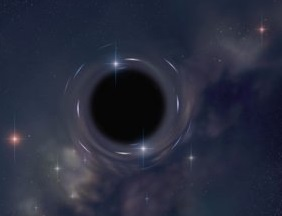
Black hole is a region exhibiting such strong gravitational pull that nothing, including particles and light can escape from it. It is formed when the inward gravitational collapse of a massive star cannot be halted. It grows by capturing matter, energy, or by merging with other black holes.
Event horizon of black hole: Surface around black hole through which, matter and light can only pass inward. Therefore, if event occurs within this boundary, then the information from the event cannot reach an outside observer; due to which, it is impossible to determine if the event occurred.
Hawking radiation: Release of garbled information to the universe, processed by the black hole
Entropy: Measure of disorder and unpredictability in a system
Dissipative structure: An unstable system that spontaneously exchanges matter and energy with its surroundings for its existence
Negentropy: Measure of contrast in orderliness of a dissipative structure relative to its immediate surroundings (determined by the release of mass or energy, which dissipative structure has processed)
Black holes fascinate all, as they are different from worldly lifeless objects, planets, and stars that orbit a higher level. These objects have entropy, which is a measure of the disorder and unpredictability in the object. Therefore, the theory of pioneering researchers on black holes (which include, Stephen W. Hawking & Jacob D. Bekenstein) initiated in the 1970s, was based on attributing the black hole with an entropy. Black holes are characterised by an event-horizon ‘a sphere’, which is a boundary that defines the point of no-return for the known limit based on the speed of light. The area of the event-horizon, which is the projected area of this sphere (a circle), is popularly believed to correlate with the black hole’s entropy, ever since the proposal of Hawking in 1974. This correlation enabled the formulation of the foundations of the theory of black hole thermodynamics in similar lines with the ubiquitous Laws of Thermodynamics. But this correlation does not explain:
i. The decreasing event horizon area (i.e.decreasing entropy)of a decaying black hole. Hawking attempted to explain this in a roundabout manner based on what he termed as, ‘a violation of the weak energy condition’.
ii. The merger of black holes and the increase in the event-horizon area (i.e. increase in entropy after merger) beyond the sum of the areas of the unmerged black holes which individually cannot decrease. But the individual system entropy can decrease so long as the total entropy increases (as per the 2 nd Law of Thermodynamics). Hawking acknowledged this unaddressed point as a ‘missing link’ in correlating the event-horizon area of a black hole with its entropy.
Our group is working in the interdisciplinary field of Black hole Thermodynamics since 2012. Ms. Pallavi Rastogi, Research Scholar in the Dept. working with Prof. Mahulikar, started contributing to this field since January 2016. Their research viewed black holes as unstable entities unlike stable & life-less orbiting mass, e.g. planets and stars. Black holes exist by continuously exchanging energy (& matter) with the universe; therefore, they ‘kind of have a life’ in them, termed as ‘dissipative structure’ by the Nobel Laureate Ilya Prigogine in 1978. A dissipative structure (e.g. human being, hurricane, eco-system), which is basically unstable, exists due to continuous exchange of energy (& matter) with its surroundings. A dissipative structure has a ‘negentropy’, a concept proposed by the Nobel Laureate Erwin Schroedinger in 1945. The negentropy is the contrast in the orderliness of the dissipative structure relative to its immediate surroundings.
A black hole can be formed when the inward gravitational collapse of a massive star (due to running out of fuel for nuclear fusion reaction) cannot be halted. It captures anything (including the omnipresent cosmic microwave background radiation) that is incident on its event horizon, by virtue of its immense gravity, and thereby grows. It releases garbled information in the form of Hawking radiation to the universe; therefore, a ‘black’ hole is actually a ‘very dark gray’ hole. Larger the black hole, more garbled is this information release. Hence, a black hole has a negentropy in addition to entropy; where, a black hole’s negentropy is the contrast in its orderliness relative to the orderliness of the released Hawking radiation. In their recent research finding, accepted by the reputed, Canadian Journal of Physics, they for the first time attributed black hole with a negentropy.
The negentropy of the black hole directly correlates with its event-horizon area and this correlation is much stronger than the well-known correlation between the black hole’s entropy with the event-horizon area. Therefore, the negentropy- based theorems and corollaries that explain the existence, growth, and decay of a dissipative structure, can now be applied to black holes. The applicable negentropy-based theorems and corollaries directly explain the decreasing event horizon area for decaying black hole, without violating established theorems. These negentropy- or energy and releasing based theorems and corollaries also address the ‘missing-link’ as acknowledged by Hawking in studying the merger of black holes. The event horizon areas of individualexistingblack holes cannot decrease as per the ‘Negentropy theorem’. The Negentropy theorem states – “for a dissipative structure to exist, its negentropy (event horizon area in the case of a black hole) must increase”. This theorem is the anti-symmetric form of the 2 nd Law of Thermodynamics, when applied to a dissipative structure with a negentropy. As per its converse – ‘the negentropy of a decaying dissipative structure will decrease until it reduces to zero’.
The ongoing research in our lab extends these findings, to understand the role of the age of the universe on the existence, growth, and decay of black holes of different mass-energy contents.
Prof. S P Mahulikar
